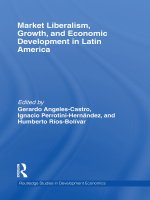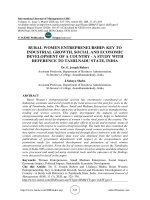Economic growth and economic development 88
Bạn đang xem bản rút gọn của tài liệu. Xem và tải ngay bản đầy đủ của tài liệu tại đây (129.17 KB, 1 trang )
Introduction to Modern Economic Growth
whenever k > k ∗ , k˙ < 0, so that the capital-effective labor ratio monotonically
converges to the steady-state value k∗ .
Example 2.2. (Dynamics with the Cobb-Douglas Production Function)
Let us return to the Cobb-Douglas production function introduced in Example 2.1
F [K, L, A] = AK α L1−α with 0 < α < 1.
As noted above, the Cobb-Douglas production function is special, mainly because it
has an elasticity of substitution between capital and labor equal to 1. Recall that for
a homothetic production function F (K, L), the elasticity of substitution is defined
by
∙
∂ ln (FK /FL )
σ≡−
∂ ln (K/L)
(2.36)
¸−1
,
where FK and FL denote the marginal products of capital and labor. In addition,
F is required to be homothetic, so that FK /FL is only a function of K/L. For
the Cobb-Douglas production function FK /FL = (α/ (1 − α)) · (L/K), thus σ = 1.
This feature implies that when the production function is Cobb-Douglas and factor
markets are competitive, equilibrium factor shares will be constant irrespective of
the capital-labor ratio. In particular:
R (t) K (t)
Y (t)
FK (K(t), L (t)) K (t)
=
Y (t)
αK (t) =
αA [K (t)]α−1 [L (t)]1−α K (t)
A [K (t)]α [L (t)]1−α
= α.
=
Similarly, the share of labor is αL (t) = 1 − α. The reason for this is that with
an elasticity of substitution equal to 1, as capital increases, its marginal product
decreases proportionally, leaving the capital share (the amount of capital times its
marginal product) constant.
Recall that with the Cobb-Douglas technology, the per capita production function takes the form f (k) = Ak α , so the steady state is given again from (2.33) (with
74









